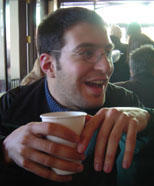Random Thoughs on Big Polymers
Yesterday I attended an interesting talk by Xuetong Shen from University of Texas (Smithvile, TX) about how actin, a cytoskeletal protein normally found in the cytoplasm, was a component of several chromatin remodeling complexes. For non biologists, chromatin is the DNA/protein complex that makes up our chromosomes and is found in the nucleus. DNA is wrapped around a proteinacious complex, called the nucleosome. For more on this topic click here.
Why is actin in the nucleus and why hasn’t anyone ever seen it before? (Alright some have claimed to have done so.) Perhaps actin polymerizes in short sequences and acts as a mini track thus providing a surface to push nucleosomes along the length of a DNA strand? These remodeling complexes also help fix DNA double strand brake – perhaps short actin polymers act like “splints”?
But another strange fact popped into my head – a fact we use to think about when I was in the cytoskeletal field ... DNA, membranes and the cytoskeletons are the 3 biggest continuous portions of the cell, and all three of these are highly negatively charged. There is something to that … but I’m not sure what …
Why is actin in the nucleus and why hasn’t anyone ever seen it before? (Alright some have claimed to have done so.) Perhaps actin polymerizes in short sequences and acts as a mini track thus providing a surface to push nucleosomes along the length of a DNA strand? These remodeling complexes also help fix DNA double strand brake – perhaps short actin polymers act like “splints”?
But another strange fact popped into my head – a fact we use to think about when I was in the cytoskeletal field ... DNA, membranes and the cytoskeletons are the 3 biggest continuous portions of the cell, and all three of these are highly negatively charged. There is something to that … but I’m not sure what …


<< Home